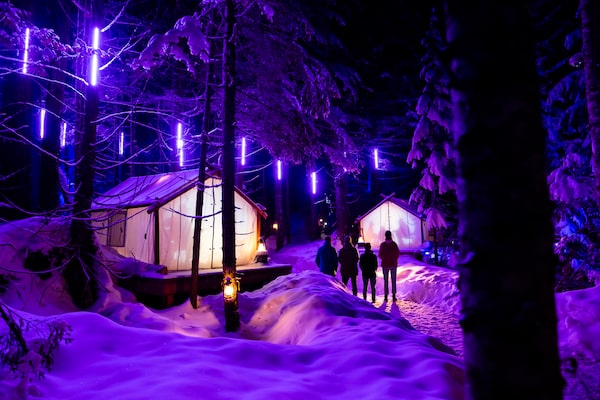
Vallea Lumina is an immersive light and sound installation that turns a scenic trail into a storytelling walk in Whistler, B.C.Handout
On one of the darkest days of the year, I found myself basking in light. I wasn’t on a sun-drenched beach, rather I walking through an illuminated forest in Whistler, B.C.
Thanks to Vallea Lumina, an immersive light and sound installation that turns a scenic trail into a storytelling walk, it’s possible to appreciate the depth of the West Coast’s wilderness after the sun has dipped behind the mountains. While I had arrived jet-lagged, it wasn’t long before I was smiling under what felt like stardust – colourful lights refracting off fluffy snowflakes.
“This is forest bathing on steroids,” I said out loud to myself as I meandered past glowing pine trees adorned with fluorescent fungi.
Vallea Lumina, created by Montreal-based multimedia studio Moment Factory and Whistler tour operator The Adventure Group (TAG), is one of many sensory-immersive experiences attracting crowds. After the success of the show’s summer installation, which launched in 2018, it now offers a winter journey (running nightly until April 22).
Moment Factory is creating similar experiences worldwide, with new Lumina Night Walks popping up in France and Japan and attracting more than two million visitors. Other companies are getting in on the act. Oslo-based Fjord Studio recently co-produced Nordic Lights, which will see six sustainability-inspired light installations by Canadian and international artists illuminate Toronto’s Harbourfront Centre Campus nightly from Jan. 27 to Feb. 13.
Currents: Niagara’s Power Transformed at the Niagara Parks Power Station.Handout
Meanwhile, Thinkwell Studio Montreal recently designed and produced Currents: Niagara’s Power Transformed at the Niagara Parks Power Station, an interactive walk where projected effects react to movement. With more of these types of projects set to expand to Eastern Canada, it’s safe to say our collective obsession with light isn’t waning.
Using light to drive tourism is nothing new. The first son et lumière show took place at France’s Château de Chambord in 1952 and went on to spawn sound and light productions at the Parthenon and Pyramids of Giza. More than half a century later, immersive installations still dazzle the masses, yet our technology – and understanding of light’s mood-altering effects – continues to evolve. Apparently, the elation I felt while walking through Whistler’s enchanted forest is universal.
“It’s the discovery of light as a vehicle for pleasure,” says Dr. Norman Rosenthal, a South African psychiatrist who first described seasonal affective disorder (SAD) in the 1980s and pioneered the use of light therapy for its treatment.
“The fact is that light can give joy to anybody. Especially if it’s coloured, varied and bright.”
Light can affect mood indirectly through our retinas’ rods and cones, which stimulate pathways that affect sleep and circadian rhythms. More recently, research from Johns Hopkins University, Brown University and the University of Maryland found that light can also influence mood more directly through the intrinsically photosensitive retinal ganglion cells (ipRGCs), which stimulate a part of our brain responsible for regulating light-dependent changes in mood, says Rosenthal.
Part of the joy of Vallea Lumina was experiencing it in a communal setting. This concept of a “digital campfire” that gets people off the couch and away from their screens has contributed to the success of these projects, says Manon McHugh, Moment Factory’s business development and marketing director.
These experiences also appeal to destinations looking to diversify their offerings. In the town of Coaticook, Que., tourism grew by 80 per cent after Foresta Lumina launched in 2014. Restaurants and hotels were packed because people were staying overnight after the show, says McHugh.

Nightrise, in Banff, includes mesmerizing light play and soundscapes featuring the Stoney Nakoda dialect.Handout
Local artisans, historians and storytellers are benefiting as well. For their latest project, Nightrise, in Banff, Moment Factory collaborated with members of the Stoney Nakoda Nation to bring their stories to the forefront of the experience, including mesmerizing light play and soundscapes featuring the Stoney Nakoda dialect. Nightrise runs until March 12 at the top of the Banff Gondola.
While First Nations culture hasn’t always been a touristic focal point of Banff, the experience is encouraging more people to connect with the region’s history and culture. It’s also prompting residents to rediscover their own backyard, as was the case in Montreal when Aura, an immersive exhibit at the Notre-Dame Basilica, launched in 2017.
“Aura came along and then suddenly, visitorship just exploded. A lot of Quebeckers were coming back and rediscovering the Basilica that they hadn’t been to since they were kids,” McHugh says. “It’s allowed sites to repurpose their venues and have people discover them again in a new light.”
For travellers, that also means the chance to enjoy fresh experiences in historical places. Later this year, Moment Factory will launch its next iteration of Aura at Paris’s Dôme des Invalides, a site that holds the tomb of Napoleon I. The nightly show will combine orchestra music and video mapping to highlight the building’s baroque architecture.
The beauty of these experiences is their ability to augment life’s simple pleasures. While I had come to Whistler to ski, I found a deeper appreciation for snowfall under the magical glow of LEDs – and the warm, fuzzy feeling of a new kind of campfire.
Keep up to date with the weekly Sightseer newsletter. Sign up today.